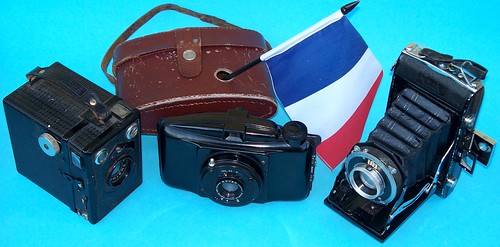Difference between revisions of "France"
m (cp to cw photo pool, image attribs) |
(text corrected) |
||
| Line 16: | Line 16: | ||
|image_rights= pd | |image_rights= pd | ||
}} | }} | ||
| − | Nowadays photomaniacs consume films and camera memory cards like foodstuffs. Thus it's no wonder that the country with the highest food culture gave us photography. It was invented in the Saône valley in Burgundy, more than 180 years ago by a Frenchman named [[Nicéphore Niépce]]. Only one of his | + | Nowadays photomaniacs consume films and camera memory cards like foodstuffs. Thus it's no wonder that the country with the highest food culture gave us photography. It was invented in the Saône valley in Burgundy, more than 180 years ago by a Frenchman named [[Nicéphore Niépce]]. Only one of his images is still existing, the others were lost by his attempts to make printing plates of them. The one photo shows us the backyard of his house in Saint-Loup-de-Varennes, mainly the roofs of the buildings around it, in 1826. It needed an exposure time of 8 to 10 hours. Archeologigal research has been undertaken to find out the window from which the photo was taken. It has been proved that the window was relocated 70 cm aside since then to make place for a new chimney, but it's still existing, together with one of the most magic and best museums about early photography, the Maison Niépce in the Rue Nicéphore Niépce number two (access through another house on the other side of the street). |
Of course most basics of what we call [[analog]] photography were invented by Frenchmen: The first published photographic process was invented by [[Louis Jacques Mandé Daguerre]] who had learned scientific photographical research from Niépce, the color photography was invented by [[Louis Ducos du Hauron]], and the [[instant camera]] by [[Appareil Dubroni No 1|Jules Bourdin]]. Others were main supporters of the further evolution of photography, for example the family [[Lumière]] invented [[color film]] (for photography) and popularized [[cinematography]] (black & white). Producers of cameras, photo optics and photo chemicals emerged around that bunch of inventive geniuses. And today lenses of [[Angénieux]] are highly in demand by collectors as well as the legendary [[Photosphère]] metal camera. | Of course most basics of what we call [[analog]] photography were invented by Frenchmen: The first published photographic process was invented by [[Louis Jacques Mandé Daguerre]] who had learned scientific photographical research from Niépce, the color photography was invented by [[Louis Ducos du Hauron]], and the [[instant camera]] by [[Appareil Dubroni No 1|Jules Bourdin]]. Others were main supporters of the further evolution of photography, for example the family [[Lumière]] invented [[color film]] (for photography) and popularized [[cinematography]] (black & white). Producers of cameras, photo optics and photo chemicals emerged around that bunch of inventive geniuses. And today lenses of [[Angénieux]] are highly in demand by collectors as well as the legendary [[Photosphère]] metal camera. | ||
Revision as of 11:11, 29 August 2013
| French | () | |
|---|---|---|
| companies | ||
| AFR | Alsaphot | André and Lieutier | Angénieux | Arca Swiss | As de Trèfle | Atoms | Aubertin | Balcar | Bardin | Bauchet | Baudry | Bellieni | Berthiot | Boumsell | Boyer | Bronzavia | Cindo | Cord | Cornu | Coronet | Darlot | Demaria-Lapierre | Derogy | Faller | FAP | Fex | Français | Compagnie Française de Photographie | Gallus | Gaumont | Georges Paris | Girard | Gitzo | Goldstein | Héard & Mallinjod | Hermagis | Idam | Itier | Jousset | Joux | Kafta | Kinax | Kodak Pathé | Krauss | Lumière | Lund | Mackenstein | Manufrance | MAPED | Mazo | MFAP | MIOM | Mollier | Mundus | Olbia | Omega | OPL | Pierrat | Richard | Richard (Jules) | Roussel | Royer | SEM | Secam | SIAP | Soulé | Spirotechnique | Tiranty | Vergne | Zion (France) | ||

|
| caméras Gauloises: Scoutbox, Photax, and Kinax image by Uwe Kulick (Image rights) |

|
| earliest preserved photo (Image rights) |
Nowadays photomaniacs consume films and camera memory cards like foodstuffs. Thus it's no wonder that the country with the highest food culture gave us photography. It was invented in the Saône valley in Burgundy, more than 180 years ago by a Frenchman named Nicéphore Niépce. Only one of his images is still existing, the others were lost by his attempts to make printing plates of them. The one photo shows us the backyard of his house in Saint-Loup-de-Varennes, mainly the roofs of the buildings around it, in 1826. It needed an exposure time of 8 to 10 hours. Archeologigal research has been undertaken to find out the window from which the photo was taken. It has been proved that the window was relocated 70 cm aside since then to make place for a new chimney, but it's still existing, together with one of the most magic and best museums about early photography, the Maison Niépce in the Rue Nicéphore Niépce number two (access through another house on the other side of the street).
Of course most basics of what we call analog photography were invented by Frenchmen: The first published photographic process was invented by Louis Jacques Mandé Daguerre who had learned scientific photographical research from Niépce, the color photography was invented by Louis Ducos du Hauron, and the instant camera by Jules Bourdin. Others were main supporters of the further evolution of photography, for example the family Lumière invented color film (for photography) and popularized cinematography (black & white). Producers of cameras, photo optics and photo chemicals emerged around that bunch of inventive geniuses. And today lenses of Angénieux are highly in demand by collectors as well as the legendary Photosphère metal camera.